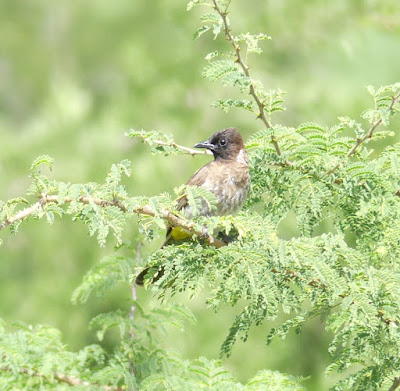In the rain shadow of Mount Kilimanjaro and up against the border with Kenya, Mkomazi NP is home to a few bird species that just sneak into Tanzania. We had a final week of summer break before Jenny's students return so headed off to the park for a couple of days. It looked an easy drive on paper - a sealed road to Same then a few km of gravel. Only 190 km each way - on the main highway between Arusha and Dar es Salaam. Driving here however is not the same as driving in regional Victoria. There are villages every few km so you are constantly slowing to below 50 km/h. Between the villages you are often sitting behind slow trucks. With a couple of birding stops it took about 8 hours each way.
A highlight on the way was stunning views of Mount Kilimanjaro with a good cover of snow. Although the glaciers are melting it still snows regularly but the mountain is often hidden. We stopped at a few places for photos.
We spent three nights at the Elephant Motel in Same town a few km from the park entrance. It is a very comfortable motel with perfectly fine rooms and good prices. We had full board and were given residents rates. The packed lunches we took into the park were as good as we have had anywhere.
 |
| Wahlberg's Epauletted Fruit Bat roosting in a palm at Elephant Motel |
 |
| This species also lives in our Arusha garden but we haven't found their roost. |
 |
| A camel was a surprise sighting in Same village. |
We had two full days in the park. I'd watched a few short Youtube videos and was expecting a semi-arid landscape - it was full of 1m high lush, green, seeding grass. The park has had a sad history. It was only declared in 2008. Prior to that it was extensively grazed with cattle, sheep and goats. It has also been heavily poached and legally trophy hunted. We noted how the larger mammals are all still extremely nervous of people and cars. Most of our sightings were of beasts in the far distance or disappearing rapidly into the bush. Numbers are still low also after the decades of abuse. We had the park almost to ourselves with only one other tourist car seen on day one and none on day two.
 |
| Most mammal sightings were like this. |
 |
| A couple of the male giraffes we saw were huge. |
We were given a pamphlet at the gate with a tiny map that was worse than useless. Many of the park's roadsigns were missing or so trashed by elephants that they weren't legible so on the first day we ventured down tracks that quickly deteriorated to the point where we had to turn back. There were apparently two picnic areas that we totally missed on day one. We eventually stumbled on one of them after lunch on day two.
 |
| View from an elusive picnic ground over Dindira dam. |
The vegetation, scenery and birdlife were spectacular. I failed to find any of my target species but managed a couple of new species (Eastern Black-headed Batis and Dodson's Bulbul) and a few other species I'd only seen elsewhere in Africa or Europe (Quailfinch, Common Whitethroat, Northern Carmine Bee-eater). All up we saw 85 species on day one, 84 on day two and 108 combined. I was happy with this given the lack of water and hence waterbirds in the park. Large numbers of widows, whydahs, bishops and indigobirds were present with many coloured-up males. In huge numbers were Red-billed Quelea and Harlequin Quail. The Quelea were a major distraction but the Quail were entertaining as they whizzed off from the roadside grass in small groups every 50 m or so.
 |
| Black-winged Kite (photo by Jenny) |
 |
| White-browed Coucal |
 |
| Long-tailed Paradise Whydah |
 |
| A courting pair of Eastern Black-headed Batis |
 |
| White-winged Widow |
Raptors were scarce - no Vultures at all - and we saw no Bustards or Lapwings. Possibly they were hidden by the long grass. Larks were also missing with only a single Flappet Lark seen.
 |
| Northern Carmine Bee-eater (photo by Jenny) |
 |
| White-browed Coucal, Laughing Dove and Lilac-breasted Roller |
 |
| Blue-cheeked Bee-eater |
 |
| Red-and-yellow Barbet (photo by Jenny) |
 |
| Dodson's Bulbul |
A final lifer at a stop on the way home was a Hunter's Sunbird in scrubland west of the highway.
 |
| Slender Chameleon |



















No comments:
Post a Comment